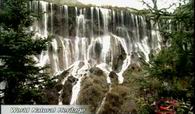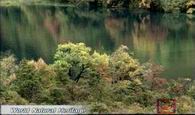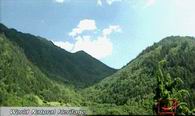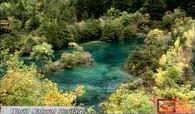Jiuzhaigou enjoys worldwide fame for its astonishing scenery. Located in the Aba Tibetan and Qiang Autonomous Region, Sichuan Province, Jiuzhaigou is a valley that stretches for more than 40 kilometers at the foot of the snow-capped Minshan Mountain.
 More than 100 lakes of different sizes are scattered in the valley. These lakes with brilliant colors are called “haizi” by the local Tibetan people, which means the sea. It is these alpine lakes that make Jiuzhaigou a fantastic place. Disposed in a stepped-like fashion in the valley, the lakes are always connected with waterfalls. Between the primeval forests and the lakes, there are nine villages of Tibetan people, and the name Jiuzhaigou means Nine Village Valley.
More than 100 lakes of different sizes are scattered in the valley. These lakes with brilliant colors are called “haizi” by the local Tibetan people, which means the sea. It is these alpine lakes that make Jiuzhaigou a fantastic place. Disposed in a stepped-like fashion in the valley, the lakes are always connected with waterfalls. Between the primeval forests and the lakes, there are nine villages of Tibetan people, and the name Jiuzhaigou means Nine Village Valley.
The primeval forest at Jiuzhaigou is nearly 30,000 acres, which contains more than 2,500 rare plants and a dozen rare animals under state protection including pandas, which also have been found here. The discovery of Jiuzhaigou is related to a panda-rescue program. The pandas once were endangered because of the blooming of arrow bamboos here. When experts came to rescue the pandas they were startled by the beauty of Jiuzhaigou. Thus Jiuzhaigou became a protected scenic area.
 The magic of Jiuzhaigou lies in the water – the alpine lakes and waterfalls. Pure and clear as they are, the lakes of Jiuzhaigou have gorgeous colors. The colors of the lakes change with the variance in light angle and intensity and changing of seasons. The lakes at Jiuzhaigou are of different types and shapes. In Shuzheng Valley, Rize Valley and Zechawa Valley, there are 114 lakes of different sizes disposing like a ladder. The 19 lakes in Shuzheng Valley are named “seas of Shuzheng”. Each is over 100 meters in distance to another.
The magic of Jiuzhaigou lies in the water – the alpine lakes and waterfalls. Pure and clear as they are, the lakes of Jiuzhaigou have gorgeous colors. The colors of the lakes change with the variance in light angle and intensity and changing of seasons. The lakes at Jiuzhaigou are of different types and shapes. In Shuzheng Valley, Rize Valley and Zechawa Valley, there are 114 lakes of different sizes disposing like a ladder. The 19 lakes in Shuzheng Valley are named “seas of Shuzheng”. Each is over 100 meters in distance to another.
Wolong Lake --- A milky white travertine dyke lying in the middle of the lake looks like a huge dragon lying across the bottom of the lake. Thus the lake is called Wolong Lake, which means Lying Dragon Lake.
Mirror Lake --- In the morning when the wind stops, you can see the reflection of the valley in the lake which reminds us of the treasure mirror of the goddess in a local legend.
Multi-Color Lake --- Of all the lakes of different shapes and colors, Multi-Color Lake, altitude of 3,000 meters, is the most special one. Its color is radiant peacock blue, which creates an atmosphere of peace and mystery.
 The lakes at Jiuzhaigou are disposed at different altitudes, which provide a perfect geographical environment for the forming of waterfalls. There are 17 waterfalls in at Jiuzhaigou, of which Pear Fall, Nuorilang Fall and Panda Fall are the most famous. Pear Fall and Nuorilang Fall are both 300 meters wide, and Panda Fall is 50 meters wide. There are no other scenic areas that posses so many beautiful waterfalls as Jiuzhaigou.
The lakes at Jiuzhaigou are disposed at different altitudes, which provide a perfect geographical environment for the forming of waterfalls. There are 17 waterfalls in at Jiuzhaigou, of which Pear Fall, Nuorilang Fall and Panda Fall are the most famous. Pear Fall and Nuorilang Fall are both 300 meters wide, and Panda Fall is 50 meters wide. There are no other scenic areas that posses so many beautiful waterfalls as Jiuzhaigou.
Long Lake --- Long Lake is located at an altitude of 3,060 meters, the highest point of Jiuzhaigou. Long Lake is about eight kilometers long, and more than four kilometers deep at its deepest. It has a vast water area, but no water outlets have been found on the surface of the earth until now. It never floods during the rain season in summer or autumn and never becomes dry during the drought in winter or spring. It is said that monsters often appear here, which makes Long Lake a more mysterious place.
All the lakes at Jiuzhaigou are as pure as crystal. More surprisingly, each of them has a special color. Why are the colors of the lakes so gorgeous?
Five-Flower Lake --- Five-Flower Lake is located at the center of Jiuzhaigou. Its color changes at times. Sometimes it turns to goose-feather yellow, sometimes it turns to ink-green, but most of the time it is a clear diamond-blue. Five-Flower Lake remains as a mystery. In the 1890s Jiuzhaigou suffered a draught for years, Five-Flower Lake was still full even when Panda Lake, the lake at its upper reaches, became dry. Moreover, Five-Flower Lake never freezes while other lakes at Jiuzhaigou all freeze during winter. Because of all these aforementioned reasons, the local people feel awe with regards to Five-Flower Lake. Why does Five-Flower Lake never freeze or dry up?
 Local people all believe that Five-Flower Lake is very mysterious because it never freezes in winter even when other lakes all become frozen. Sometimes bubbles are noticed coming out of the surface of the lake.
Local people all believe that Five-Flower Lake is very mysterious because it never freezes in winter even when other lakes all become frozen. Sometimes bubbles are noticed coming out of the surface of the lake.
Fan Xiao, professor of the Sichuan Geology Team, has been studying Five-Flower Lake for years. He comes with divers, and he wants to find out the reason why Five-Flower Lake never freezes. His assumption is there are springs at the bottom of Five-Flower Lake, which provide for a constant temperature even during winter and draught seasons. However, the existence of these temperature-moderating springs has never been proved.
“There is only travertine and not very much alga and hydrophyte. The outlets of the springs should be located at places with considerable travertine deposits,” said Professor Fan Xiao.
An underwater test shows that Five-Flower Lake is so clear that one can see as far as 40 meters when under its surface.
Professor Fan and his colleagues finally found a small cave. Searching along the fault line, they found more small lime-eroding caves. These lime-eroding caves are called stalactites which are usually found at variable zones, and it is very rare to be found at an altitude of more than 3,000 meters. To find stalactites at such a landform is very rare. This is also an important evidence of the discovery of a stream fault.
The scientists measured the angle of the fault line of earthquakes: the fault line slope is 45 degrees and the fault angle is 70 degrees. The truth is Long Lake and Five-Flower Lake are connected by a tunnel, through which the underwater spring water flows into Five-Flower Lake from Long Lake. After the analysis of water in Five-Flower Lake, the scientists discovered that the concentration of lime is 20 times than that of Long Lake. When the spring water passes through the lime tunnel, plenty of travertine comes into the water. The white sands containing travertine accumulates in a way similar to how sands build up in the tropical coral sea. Then the algae turns white due to the effect of the travertine. With the accumulation of the travertine, a dreamy underwater landscape is born.
It is the travertine accumulation that makes Five-Flower Lake such a beautiful place. The travertine is also the secret of the beauty of Jiuzhaigou.
 Jiuzhaigou stretches at altitudes ranging from 1,000 to 5,000 meters, covering a broad range of climatic zones from the Temperate Zone to the Sub-frigid Zone. Because of the complicated landform of the valley, many ancient animals and plants still exist today. More than 100 precious medicinal materials have been found here.
Jiuzhaigou stretches at altitudes ranging from 1,000 to 5,000 meters, covering a broad range of climatic zones from the Temperate Zone to the Sub-frigid Zone. Because of the complicated landform of the valley, many ancient animals and plants still exist today. More than 100 precious medicinal materials have been found here.
The forest at Jiuzhaigou is also beautiful, and the leaves in particular seem extremely special. Autumn is the most beautiful season here at Jiuzhaigou when the whole valley turns golden. The reflection of the forest in the water is so gorgeous that it makes people believe that this is a fairy tale world. Why are the forests here so beautiful?
Nuorilang Fall --- The underwater springs of Five-Flower Lake dissolves into the autumn scenery of Jiuzhaigou too. The water flows out of Five-Flower Lake with plenty of travertine, which creates amazing scenic formations downriver. Over 1 kilometer downriver is Nuorilang Fall. It is 320 meters wide and 25 meters high. The geographic structure is typical and the travertine accumulation was the reason of the beauty of Nuorilang Fall. Jiuzhaigou lies at the foot of the Himalayan Mountains, and the valley came into being during an earthquake. The outstanding height of Nuorilang Fall is caused by a fault.
The travertine accumulates at the top of the waterfall and finally forms a dyke. Gradually a beautiful lake comes into being behind the dyke. Therefore, layers of lakes and waterfalls thus come into being and finally form a steppe-like scenery.
 Wolong Lake --- The travertine-accumulating dyke will sometimes sink to the bottom of the lake. Wolong Lake, 5 kilometers from Five-Flower Lake, once had a dyke with an accumulation of travertine. However, as the waterfalls downriver expanded, the dyke sank to the bottom of the lake as if a dragon had gone to sleep.
Wolong Lake --- The travertine-accumulating dyke will sometimes sink to the bottom of the lake. Wolong Lake, 5 kilometers from Five-Flower Lake, once had a dyke with an accumulation of travertine. However, as the waterfalls downriver expanded, the dyke sank to the bottom of the lake as if a dragon had gone to sleep.
Between the lakes at Jiuzhaigou are waterfalls and streams. So trees even grow in the streams. Some trees fell in water, and over the years travertine and algae gradually covered the trunks. This became a paradise of food and amusement for fish.
Reed Lake --- Reed Lake located downriver of the Jiuzhaigou valley is 2 kilometers long. What is different about Reed Lake compared to its upriver counterparts is that it is full of reeds and is a swampland. In Reed Lake and in areas downriver, there are no more travertine landscapes.
Five-Flower Lake Winter has come to Jiuzhaigou, and the lakes and waterfalls are all frozen except Five-Flower Lake.
Time flies and soon spring will once again return to Jiuzhaigou.
|